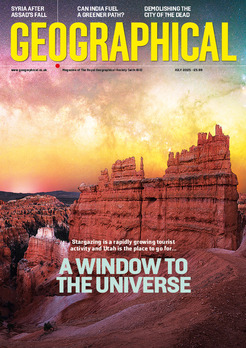
Could dredging Egypt’s degraded Bardawil Lake restore rain to the arid Sinai Peninsula?
By
The Sinai Desert was once green. Evidence suggests that as recently as 8,000 years ago, the whole of Africa’s Sahara region was an oasis of forests and grasslands. Shortly after that, over the space of just a few thousand years, the region rapidly transformed into an arid landscape. Some scientists now think that humans played a much more important role in the end of the so-called African Humid Period than was previously understood, the result of a shift from a hunter-gatherer lifestyle to one of animal herding.
‘We can debate whether the desertification of North Africa is human-induced or natural, but what if they’re both true?’ asks Ties Van der Hoeven. That’s the argument made by the latest research paper from the Weather Makers, a ‘holistic’ Dutch engineering company. Co-founder Van der Hoeven believes that, as land use in the Sinai changed, the loss of vegetation prevented the formation of clouds, allowing more and more water to evaporate from the area and increasing the rate of desertification. On a larger scale, the lack of vegetation and the resulting increase in temperatures acted as a ‘vacuum cleaner’, sucking moisture from the surrounding Mediterranean Basin and into the Indian Ocean. This theory is the basis for a very ambitious project: bringing rain back to the Sinai Peninsula.
Van der Hoeven, who has a background in maritime engineering, started out with much more modest goals. He was initially contracted to work on the restoration of Bardawil Lake, a saltwater lagoon on the peninsula’s Mediterranean coast and an important source of local and commercial fishing in Egypt. It’s currently in a concerning state; sediment build-up has reduced the lake’s depth to just a few metres, increasing salinity and decreasing fish stocks. Dredging the lake would make it deeper, improving the water quality and creating a more sustainable fish population.

Looking at the peninsula on Google Earth, Van der Hoeven could clearly see the scars of old rivers criss-crossing the desert. Within a few weeks, he’d built a vision: restore the lagoon, revive the fish stocks and create new jobs and income for the local population. The marine sediment dredged from the bottom of the lake could then be used to regreen the desert – there’s no reason why nothing would grow there, he thought. ‘And from that came the far-fetched pitch that, if you could regreen the Sinai, you would change the direction of the winds, bringing water vapour from the Red Sea and Indian Ocean back to the Mediterranean.’
Planting trees to change the weather is a pretty bizarre idea, he admits, but it isn’t without precedent. In 1994, scientists began work on transforming the heavily degraded landscape of the Loess Plateau in northwestern China. As in the Sinai, centuries of overuse and overgrazing had eroded the soil, leaving its local population impoverished. Thirty years later, the Loess Plateau is green and fertile. Studies show that the large-scale restoration has significantly increased the region’s rainfall and the World Bank, which contributed roughly US$200 million in funds, reported that ‘even in the lifetime of the project, the ecological balance was restored in a vast area considered by many to be beyond help’.
Ecologist and filmmaker John D Liu documented the success of the Loess Plateau project in his documentary Green Gold. He’s on the Weather Makers team, having taken Van der Hoeven under his wing early on and introduced him to the scientists who worked on the Loess Plateau. Their support solidified the Dutch team’s resolve to press on with their own project. Their dedication has paid off. On 6 November, on the sidelines of the COP27 negotiations, the Egyptian Prime Minister Mostafa Madbouly signed an agreement to begin work developing Lake Bardawil, with the joint aim of restoring the ecosystems of both the lake and the Sinai Peninsula.
Ecosystem restoration, such as rewilding and reforestation, is an increasingly popular concept, but Van der Hoeven says we should be aware of the root causes that lead to landscape change. Reforestation in particular has been criticised for introducing new forests to places that have traditionally supported other ecosystems. Instead, we should look to restore lost ecosystem functions. In the Sinai, increasing the amount of vegetation would kickstart an ancient water cycle. ‘If you can regreen the Sinai, you can regreen North Africa,’ he says. ‘Then you’re working at a scale large enough to realise – this could help tackle climate change.’
It’s a big vision. ‘There are many bears still on the road,’ agrees Van der Hoeven (a Dutch expression that means there are issues ahead). ‘People have called us crazy, but the evidence for the project is piling up.’




